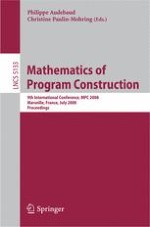2008 | Book
Mathematics of Program Construction
9th International Conference, MPC 2008, Marseille, France, July 15-18, 2008. Proceedings
Editors: Philippe Audebaud, Christine Paulin-Mohring
Publisher: Springer Berlin Heidelberg
Book Series : Lecture Notes in Computer Science
